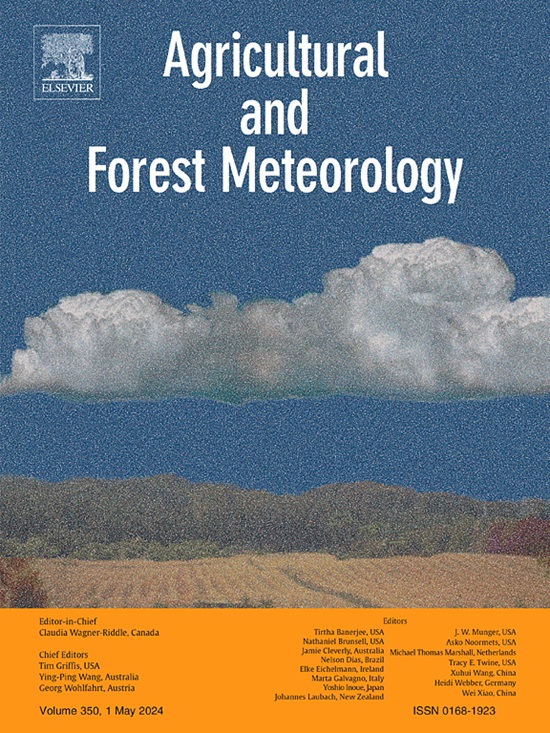Patterns of methane flux on different temporal scales and its environmental controls over a subtropical “floating blanket” wetland in southwest China
IF 5.6
1区 农林科学
Q1 AGRONOMY
引用次数: 0
Abstract
Wetlands are the primary natural source of methane (CH4) emissions to the atmosphere, however, the quantification of wetland CH4 flux and net carbon budgets remains uncertain due to limited measurements and large variability across different types of wetlands. Based on continuous measurements using the eddy covariance (EC) technique over a “floating blanket” wetland in southwest China for a period of over three years (2018–2021), we examined the temporal variations of CH4 flux and its environmental controls on different temporal scales. The results showed that this wetland acted as a sink for carbon dioxide (CO2) while simultaneously serving as a source for CH4. The annual CO2 uptake and CH4 emission was 155.9–221.2 g C-CO2 m−2 yr−1 and 44.6–56.9 g C-CH4 m−2 yr−1 during 2019–2021, respectively. The annual total carbon budget varied from -176.6 g C m−2 yr−1 to -99.0 g C m−2 yr−1. From half-hourly to monthly timescales, CH4 flux was mainly controlled by water temperature with a positive correlation. There was a negative correlation between CH4 flux and CO2 flux, and the importance of CO2 flux to CH4 flux increased as the timescale extended. CH4 flux exhibited a significant positive correlation with the ecosystem gross primary production (GPP) and respiration (Re) on daily and monthly timescales. In addition, the fraction of vegetation cover had a positive impact on CH4 emissions. There was a significant variation in the fraction of vegetation cover with wind direction. The southwestern wind sector had the highest fraction of vegetation cover compared to other sectors, leading to the formation of the CH4 emission hotspot. The cumulative CH4 emissions in the southwestern wind sector were also higher than those in other sectors, accounting for around 58.13% of the annual total CH4 emissions, while the cumulative CH4 emissions in other wind sectors accounted for 5.21%–21.50%.
中国西南亚热带 "浮毯 "湿地不同时间尺度的甲烷通量模式及其环境控制
湿地是向大气排放甲烷(CH4)的主要天然来源,然而,由于测量有限以及不同类型湿地之间的巨大差异,湿地CH4通量和净碳预算的量化仍不确定。基于使用涡度协方差(EC)技术对中国西南某 "浮毯 "湿地三年多(2018-2021年)的连续测量,我们研究了不同时间尺度上CH4通量的时间变化及其环境控制。结果表明,该湿地在作为二氧化碳(CO2)汇的同时,也是CH4的源。在2019-2021年期间,年二氧化碳吸收量和CH4排放量分别为155.9-221.2 g C-CO2 m-2 yr-1和44.6-56.9 g C-CH4 m-2 yr-1。年度总碳预算在-176.6 g C m-2 yr-1到-99.0 g C m-2 yr-1之间变化。从半小时到月度时间尺度来看,CH4通量主要受水温控制,两者呈正相关。CH4 通量与 CO2 通量之间呈负相关,随着时间尺度的延长,CO2 通量对 CH4 通量的重要性增加。在日和月时间尺度上,CH4 通量与生态系统总初级生产力(GPP)和呼吸作用(Re)呈显著正相关。此外,植被覆盖率对甲烷排放量也有积极影响。植被覆盖率随风向变化很大。与其他地区相比,西南风区的植被覆盖率最高,从而形成了 CH4 排放热点。西南风区的累积甲烷排放量也高于其他风区,约占全年甲烷总排放量的 58.13%,而其他风区的累积甲烷排放量仅占 5.21%-21.50%。
本文章由计算机程序翻译,如有差异,请以英文原文为准。
求助全文
约1分钟内获得全文
求助全文
来源期刊
CiteScore
10.30
自引率
9.70%
发文量
415
审稿时长
69 days
期刊介绍:
Agricultural and Forest Meteorology is an international journal for the publication of original articles and reviews on the inter-relationship between meteorology, agriculture, forestry, and natural ecosystems. Emphasis is on basic and applied scientific research relevant to practical problems in the field of plant and soil sciences, ecology and biogeochemistry as affected by weather as well as climate variability and change. Theoretical models should be tested against experimental data. Articles must appeal to an international audience. Special issues devoted to single topics are also published.
Typical topics include canopy micrometeorology (e.g. canopy radiation transfer, turbulence near the ground, evapotranspiration, energy balance, fluxes of trace gases), micrometeorological instrumentation (e.g., sensors for trace gases, flux measurement instruments, radiation measurement techniques), aerobiology (e.g. the dispersion of pollen, spores, insects and pesticides), biometeorology (e.g. the effect of weather and climate on plant distribution, crop yield, water-use efficiency, and plant phenology), forest-fire/weather interactions, and feedbacks from vegetation to weather and the climate system.

 求助内容:
求助内容: 应助结果提醒方式:
应助结果提醒方式:


